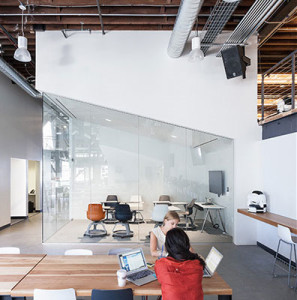 There are trends in everything, and employees are looking for a broader variety of options of work spaces to pick from based on the work they are doing and their experience outside of work.
There are trends in everything, and employees are looking for a broader variety of options of work spaces to pick from based on the work they are doing and their experience outside of work.
This trend sees a revolt against totally open offices or workplaces that don’t offer more than one way to work. The really cool places to work, i.e. Google, Zappos, Capital One, etc., are landmarks for today’s workforce who see how others work and want their employers to explore the options.
Ten to fifteen years ago, the economy was seeing less and less of a need for middle managers. There was a push toward group management, peer management, and self- directed work. That meant teams had to learn how to work with less supervision but with more transparency. In response, office design saw systems furniture walls get lower or disappear. The economy after 2005 was less than bullish, so owners and managers were shrinking the spaces they worked in even when they didn’t “downsize” the workforce.
Somewhere around 2008, we had small, open offices and a growing number of shared spaces. Collaboration and innovation were the buzz words that eclipsed teamwork and self-direction. We lived through the phase when supervision was reduced and we had to be more accountable, but our business cultures wanted us to do more, be more creative and work together too.
 Today’s business culture is asking employees to do more. Technology has made this possible and the workforce is adjusting to a different pace. Healthy environments understand how people work best and consider their needs to: be productive, meet goals, be visible, mentor, report, be accountable, collaborate and communicate.
Today’s business culture is asking employees to do more. Technology has made this possible and the workforce is adjusting to a different pace. Healthy environments understand how people work best and consider their needs to: be productive, meet goals, be visible, mentor, report, be accountable, collaborate and communicate.
At NeoCon 2014, Steelcase pronounced “Privacy: The Next Office Crisis”. They developed products that create acoustical and visual separation. Haworth and Herman Miller have been introducing open space private meeting areas that have the equivalent of wings or shields that have adaptable parts to help the users to feel more or less “open”. Haworth and Herman Miller were subtly promoting that if a team had a high level of trust, walls didn’t have to be built. They continue to invent environments that promote people working together and compromising autonomy for “cool”.
So what does the small business owner without a budget for one of the Big Three’s furniture solution do? r.o.i. Design is working with a variety of customers tackling this dilemma and have seen the following to be successful:
- Communicate with your group that you know it probably is time for a change in the office and that you are thinking about it. Be open to their ideas and casual discussions around the office. DON’T hold a town hall meeting, don’t set yourself up for a deadline and a transition you can’t promise.
- Identify other offices/workplaces that you like how they work and feel in your region. Talk to your team about them. DON’T compare yourself to Silicone Valley if you are in the suburbs of a Midwestern town. Understand what the other employers in your industry are doing in your area.
- Hire someone like r.o.i. Design to meet with you and help you start to imagine and understand what some of the options could be for:
- Adjacency – who is sitting next to who, who is supporting who, who are natural leaders and where is there cross-pollination.
- Clear roles of spaces-what is private, what is shared, what is collaborative, what is casual, what is formal etc.
- Reasonable and feasible budgets and timelines to create enough meaningful change.
- Once there is more of an understanding of what is needed, research how to get there. This is when you contact contract office suppliers and re-sellers. Remember the companies that sell furniture as their main business, may not be as open to a phased equipment purchase and may not see the value of making changes in the environment using existing furniture.
- Communicate with your team as to what you discovered and manage expectations for change. Include enough of the employees in the actual planning to facilitate “buy-in”.
- Treat the change as a management opportunity and pay attention to how your team responds. Reward them for helpful behaviors and attitude.
- Stay flexible, and execute 80% of your ideas. A new trend will start showing up in five to ten years and office remodeling will never be completely, “done”.
